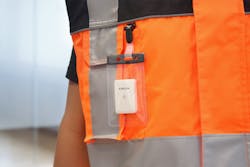As manufacturers continue to reopen operations, the key to keeping them open will rest on the company’s ability to follow predetermined guidelines designed to protect employee well-being. Successfully adhering to the minimum physical distance guidelines between employees is a prime example.
As the economy begins to reopen Kinexon anticipates that its product will only become more important for companies around the world. So far, Kinexon has successfully deployed its solution in manufacturing, logistics and food & beverage environments.
What is important to note is that the government and health professionals’ stance on physical distancing and contact tracing has not changed since the beginning of the pandemic. These are still the two most important ways to maintain employee safety, ensure stable production and help reduce employee absences. After all, production downtime can cost companies millions.
Kinexon has also seen SafeZone make a difference for sports team and leagues. One of Europe's most innovative sports franchises, Eintracht Frankfurt, successfully implemented SafeZone for all essential personnel in Commerzbank-Arena during the Bundesliga restart on Saturday May 16. This of course has major implications on sports teams and leagues in the US, as leaders establish safe plans for return-to-play.
How does it work?
The core element is a lightweight wearable sensor, the Kinexon SafeTag, which uses highly-accurate ultra-wideband (UWB) technology. The sensor visibly warns the user as soon as the minimum physical distance to another person is breached. A second audible warning is emitted if the two employees have an extensive critical contact period. The minimum physical distance and timing of a critical contact period can be adjusted. Each sensor is registered in the system with a unique ID but is not assigned to a specific person.
With optional software, companies can also trace chains of infection, enabling them to take strategic action if necessary. This enables the storage of relevant data relating to critical contact events – for example, employees being less than 6 feet apart for longer than 5 seconds – and allows for analysis compliant with data protection regulations. In the event of a positive infection report, potential cases of infection can quickly be identified using the relevant sensor IDs. The technology’s high level of precision means it only records realistic cases of infection, keeping the number of isolated employees to a minimum.
With no real infrastructure requirements, a fast implementation and flexible scaling of the solution across production environments or office areas is feasible. By using UWB, all data is 10 times more accurate compared to solutions based on Bluetooth or WLAN. In addition, UWB technology is characterized by the fact that it does not interfere with other radio technologies (e.g. Bluetooth, LTE or WLAN).






